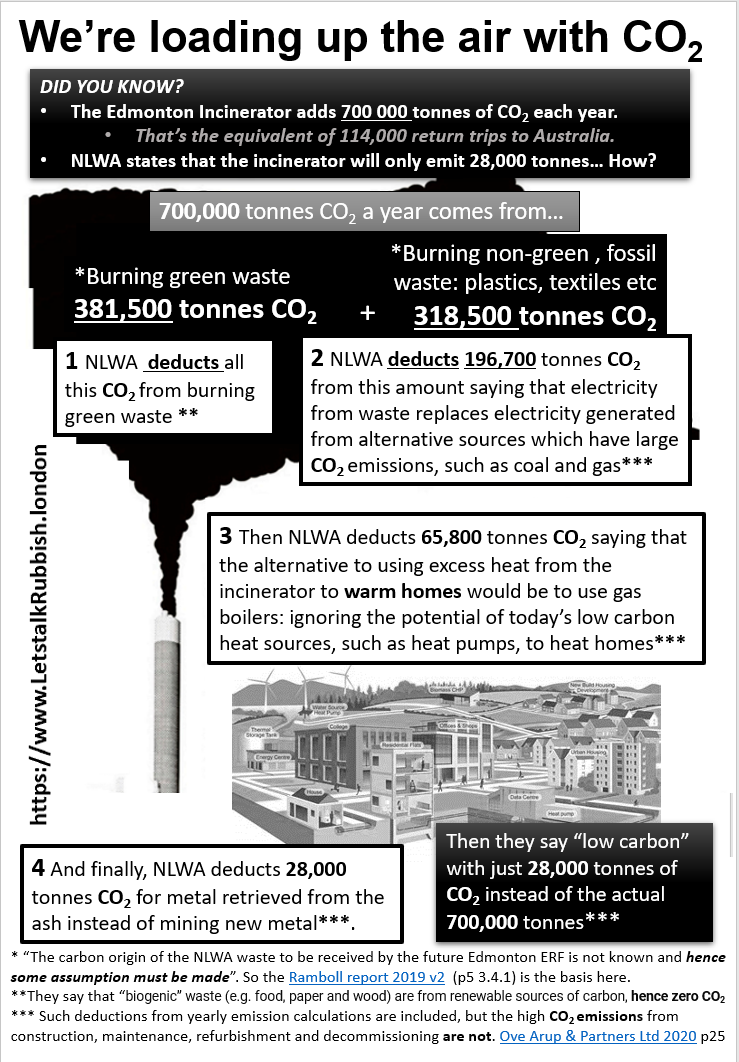It’s high carbon not low carbon: the accounting trick for energy from waste incineration
North London Waste Authority (NLWA) members, the seven councils of north London, want a new, bigger incinerator at Edmonton. To justify the new incinerator that will burn our rubbish for at least another 30 years, the NLWA promotes the message that the incinerator will be low carbon and good for the climate. How? by using a series of carbon accounting tricks., to make it look like the new incinerator will reduce CO2 emissions.
The campaigners that are part of Stop The Edmonton Incinerator Now, who don’t want a new incinerator at Edmonton, calculate that the incinerator will be high carbon – bad for the climate and will emit 700,000 tonnes of CO2 a year. This is a very high amount of CO2, about 10% of the total CO2 emissions of all activities in North London. In comparison, the NLWA states that the new incinerator will only emit 28,000 tonnes of CO2 a year.
Who to believe?
As a general rule of thumb one tonne of CO2 is emitted when one tonne of waste is burnt. This is not disputed and agreed on widely in the industry. It is based on simple chemical science of combustion. A tonne of waste contains a lot of carbon that is released when burnt. The new incinerator under construction in Edmonton is designed to burn 700,000 tonnes of ‘residual waste’. Mostly from North London and some brought in from elsewhere – hence the 700,000 tonnes CO2.
The NLWA are using allowed accounting rules to deduct the CO2 from burning the ‘biogenic’ waste, such as food, garden and cardboard, which reduces the figure to 318,500 tonnes. Then they are allowed (though disputed) to deduct the emissions caused by generating electricity from natural gas, based on accounting rules from 2014 that when the incinerator is turned on, a natural gas power plant is shut down. This is flawed because the UK is phasing out natural gas generation on the electricity grid by 2035. Then they are allowed (though disputed) to deduct the difference between using heat for homes by incinerating waste rather than from individual gas boilers,. Lastly they are allowed to deduct CO2 emissions for the metal retrieved and recycled from the ash rather then newly mined. These three deductions result in a total net emissions profile of 28,000 tonnes of CO2.
In reality, it is the 700,000 tonnes that goes up into the atmosphere – not the 28,000 tonnes, and falsely claiming the latter is a key reason why the low carbon alternatives to incineration of retrieving plastics and biogenic waste are not considered.
Note that the accounting tricks are to focus on ‘allowed to calculate’ from interpretations of regulations, rather than focusing on the actual expected emissions. Claiming that ‘allowed’ is the same as ‘IS’ is the same logic used by Grenfell cladding installers, who seemed to think that ‘allowed to install’ was the same as the panels actually being ‘fireproof’.
References
Base Reports
1. NLWA’s North London Heat and Power Project carbon impact screening Edmonton ERF ver 2 by Ramboll October 2019. See page 6 for tonnes of CO2 per tonne of waste
Note that the NLHPP carbon offseting and abatement report 13 May 2020 p25 said that Ramboll did not take into consideration any “CO2 emissions (including embodied carbon) from capital inputs to the ERF such as construction, maintenance, refurbishment and decommissioning. This is an important component in determining the overall carbon footprint of the ERF and subsequently, the requirement to reduce its CO2 emissions.” These are on top of yearly emissions, and necessarily higher for a larger building.
For more detailed calculations for different methods of disposing of waste, UK without Incineration – UKWin has this in it’s 2021 Incinerator 2021 Incinerator GHG Guide Note that the NLWA does not use, or intend to use landfill, due to cost and unavailability regardless of the greenhouse gas implications.
‘Allowed’ - IPCC references
The IPCC (p7) does advise to not count emissions in National reporting from turning biomass, including household waste into ‘bioenergy’ (as per incineration).
However the IPCC FAQ: Do the IPCC consider biomass used for combustion carbon neutral? Q2.10 says “The approach of not including these emissions in the Energy Sector total should not be interpreted as a conclusion about the sustainability or carbon neutrality of bioenergy.” Clearly the NLWA does interpret not needing biogenic emissions to be included in the UK Energy Sector total IS interpreted as a conclusion about the carbon neutrality of bioenergy.
Further Reading
On the “carbon accounting loophole.” https://redgreenlabour.org/2021/12/12/the-millions-of-tons-of-carbon-emissions-that-dont-officially-exist/
